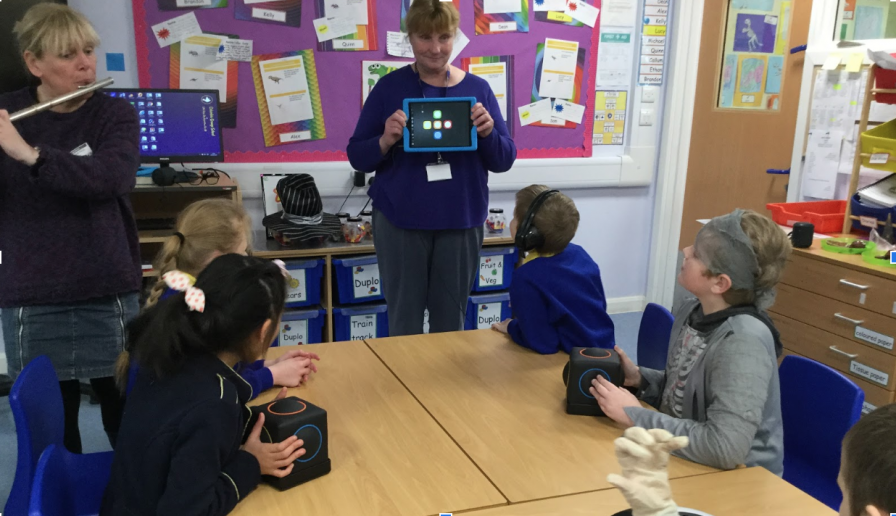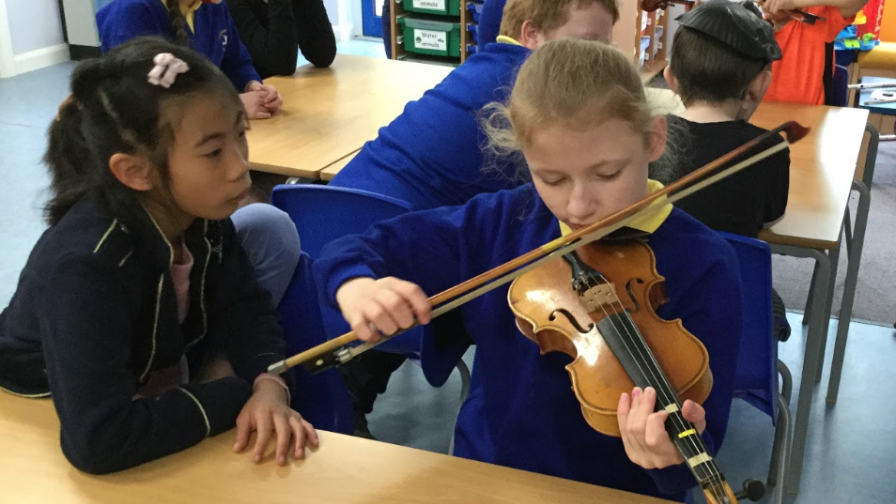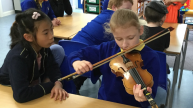Creative Music Making with Young People with SEN/D

Hello! We’re Sunderland Empire Creative Learning & Community Partnerships (CLCP)!
Welcome to our first blog on the Youth Music Network. We’ll be sharing the journey of our first Youth Music project ‘Sounds of Sunderland’ which engaged young people with special educational needs and/disabilities (SEN/D) in school settings in Sunderland to improve such provision in the city. Our aim was to positively increase the opportunity for music making in our local SEN/D settings and make music more accessible for all.
ABOUT US Before we launch into our activities, here’s a little bit more about us: CLCP are a small team based at Sunderland Empire Theatre. We facilitate a varied programme of Arts activities including music, drama and dance, based in house as well as within community spaces and schools on outreach. Collaboration is at the heart of all we do and we have a number of regional and national partners. Over the years we have developed a particularly strong partnership with Sunderland Music Education Hub (SMH) our ‘Sounds of Sunderland’ project partners. This project also continued our relationships with Churches Conservation Trust and No Limits Theatre.
OUR PROJECT
During SMH’s SEND School Music Network meeting, attended by teachers from SEN/D schools last year, it became clear that there was a lack of music making opportunities for young people with special educational needs in Sunderland. Whilst music featured in small ways across the curriculum, the music making process was less accessible to young people in SEN/D schools. We felt we could make a positive change to increase these kinds of opportunities within schools and together with SMH, we began the process of writing, submitting and succeeding with our very first Youth Music bid for ‘Sounds of Sunderland’.
We aimed to provide more music making opportunities for young people with SEN/D by establishing and nurturing music ensembles in their school settings. A large part of our delivery was to focus on ways to make music making more accessible in settings by utilising music technology (iPads, Skoog and Charanga) in conjunction with traditional instruments throughout the project.
DELIVERY: We would be engaging groups of children from SEN/D schools in the area in taster music making sessions. The tasters were instrumental as they allowed us to engage a larger range of participants (104 to be exact!) in music making activities, exploring sounds, rhythm, and composition. The taster sessions allowed participants to explore in an accessible way using traditional instruments as well as Skoog technology. If you are unfamiliar with what a Skoog is, you can find out a bit more about them here.
We wanted to ensure that our project had really strong collaborative ethos and we were able to develop positive relationships with teachers, connecting them to local musicians in the delivery phases. Teachers were empowered through the project; taking part in CPD sessions and assisting with delivery, as well as consulting with practitioners on which participants would take part in the ‘core’ delivery of our project following the initial sessions.
Core groups weren’t selected based on musical ability of each child, rather, young people were chosen based on their responses to the programme during taster sessions. The core delivery sessions allowed participants to hone in on music exploration and the city, using music to explore unfamiliar spaces and sites including Holy Trinity Church, Sunderland Empire, and Roker Beach, and compose a response to these places using ‘found sounds’ collected on the journey. This group would be working with local musicians to compose soundscapes of their explorations, ‘Sounds of Sunderland’.
The young people would be exploring heritage sites in the city including Holy Trinity and Sunderland Empire.
These visits to settings outside of familiar school settings gave practitioners a good understanding of pupils willingness and adapt to new challenges which was helpful when planning and tailoring future music sessions to each group. The visits also allowed us to explore new and different to creating music; using ‘found sounds’ around the church to question how music is made. Throughout the visits the participants collected recordings of sounds including the creak of the doors, the pitch of the brass railings in the theatre and even discovered that theatre seats lend themselves excellently to percussive sounds. We also explored the more conventional instruments in the spaces including the church organ. Following the visits we were able to capture a rich pool of sounds to be used for sampling, and which would later be factored into soundscape compositions back at school settings.
As part of the project we connected our groups to Royal Philharmonic Orchestra, building on existing connections Sunderland CLCP have with the ensemble. The national acclaim of the RPO and the chance to work with world class musicians within our settings was a fantastic supplement to the programme. We organised the meeting of musicians, participants and tecahers and the opportunity for our young people to experience a mini concert with an Octet of musicians. This element of the project delivery is a legacy to a previous schools tour Sound Around, the first relaxed partnership project between SMH and CLCP. Our work with Youth Music has encouraged participation from both groups and whole schools. Some schools also received an interactive workshop and concert experience with Live Music Now's Maia a fanastic band with extensive experience engaging participants with additional needs.
TECHNOLOGY + DIGITAL MUSICIANSHIP
The project was focused on accessibility and we were able to combine the use of traditional instruments with digital technology including:
- iPad - including Garage Band, and in conjunction with Skoogs.
- Skoog - developmental technology compatible with Apple iPads. CPD training sessions with the creator of Skoog were offered to teachers on the project as well as practitioners to upskill workforce in the region.
CPD increased the opportunity for this digital instrument, and iPads, to be used in schools as well as to encourage confidence using music technology, for the digital instruments to have a lifespan beyond this project.
I would like to think that Sounds of Sunderland has given me a bit more confidence to embark on musical journeys with the children, which would both stimulate and engage all involved Taking part has also given me incentive to look for other ways to musically engage the children, rather than use the excuse that I am not an accomplished musician myself to opt out!
Interestingly, we found that only 1 school setting out of 6 preferred to use the Skoog consistently throughout the programme. We found the Skoog most useful in settings where young people had profound needs. The instrument has a catalogue of sounds which can be accessed via a purpose built app, and can also be programmed with our ‘found sounds’ which was interesting for the children to explore. Whilst the Skoog is an accessible design, feedback from teachers suggested that the limited range of note possibilities were less suited to groups with a desire to compose more elaborate soundscapes. Garageband, whilst more complex to use, was the preferred technology of schools and participants. We found that participants were more familiar with iPads and more inclined to explore the range of sounds.
Seeing how iPad and other tecghnology can fit with more traditional instruments means that my rock bands now can have students with more diverse needs joining in even more than before. I have more confidence in adding the tech to musical performances.
PERFORMANCE
The project culminated in a final performance at Sunderland College in their professional performance studio. Many of our young people had never performed previously and this was the first instance where they would be experiencing a space of this kind. In preparation, familiarisation visits to the space were offered for each group as well as a ‘dress run’ before the real thing. This was a vital adjustment and teachers and pupils alike responded well on the visits. The groups had their own songs to showcase, however they also played a joint piece together as an ensemble which was a wonderful way to link settings project wide. Our performance was attended by representatives of cultural organisations across the city as well as by parents and teachers of the young people involved.
ACCREDITATION
Arts Award proved to be a great accreditation route for our young people’s learning on the project. All participants across the programme achieved a minimum of Discover level Arts Award, with Core participants all achieving an Explore Arts Award; connecting to the organisations we visited on an additional level and learning more about their home city through the music making process. If you’re thinking of exploring the Arts Award accreditation route for your groups, you can find more information here!
OUTCOMES + LEGACY: We're pleased to add that following the project, we were able to deliver 10 further sessions in two of our settings to continue the work and trajectory of the participants learning. This was focused on year 6 pupils as they prepared for the transition to their new secondary schools in September. A further 2 settings have estabilished new music ensembles as a direct result of taking part in the activities which is a fantastic outcome and further schools have the desire to organise similar extra cirricular activities in the future.
TIP When starting to write this blog we found Youth Music’s 8 Top Tips for Writing Excellent Blog Posts really helpful, so do check the link out if you need a little guidance when writing your own YMBlog!


